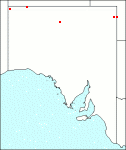|
Crotalaria medicaginea
Citation:
Lam., Encycl. 2:201 (1786).
Synonymy: C. trifoliastrum sensu Benth., Fl. Aust. 2:183 (1864), non Willd.
Common name: Trefoil rattlepod.
Description:
Ascending or decumbent densely branched shrub; stems brown, woody, to 60 cm long, with dense antrorse fusiform hairs; leaves on a pubescent petiole 3-6 mm long, 3-foliolate; terminal leaflet subtriangular to narrow-obovate, cuneate, more or less truncate, 4-20 x 2.5-7 mm, glabrous above, antrorsely appressed-pubescent below, shortly petiolulate, lateral leaflets slightly smaller; stipules lanceolate-subulate, c. 3 mm long, white-pubescent.
Flowers 6-8 mm long, in few to many (20 or more) terminal erect racemes on peduncles 1-10 cm long; bracts similar to stipules; bracteoles distal on the pedicels, filiform, to 1 mm long; pedicel pubescent, 1-3 mm long; calyx shortly campanulate, c. 3 mm long, pubescent with white appressed antrorse hairs, teeth subequal, triangular, slightly longer than the tube; petals yellow; standard cordate, subacute, on a short and wide claw; wings oblong, slightly auriculate above the short wide claw; keel triangular, widest distally, spirally twisted at the beaked apex; ovary sessile, globular, 2-ovulate; style at the base reclinate, then suddenly twisted upright and protruding from the keel.
Pod sessile, rounded-rhombic in outline, 3.5-5 mm long and broad, hooked, with a thick persistent style; seed cordiform, c. 1.5 mm, brown.
|
|
Distribution:
|
W.Aust.; N.T.; Qld; N.S.W. India; China; southern Asia (see comment).
|
Conservation status:
native
Flowering time: April — May.
|

SA Distribution Map based
on current data relating to
specimens held in the
State Herbarium of South Australia
|
Biology:
In various situations appears to be frequent and somewhat weedy.
Taxonomic notes:
"The name C. trifoliastrum is at present applied outside Australia to erect, relatively large-flowered subshrubs in India, while C. medicaginea is accepted for plants of varying habit with usually smaller flowers, distributed over a wide area from India, through Malaysia to China and Australia"
Author:
Not yet available
|

